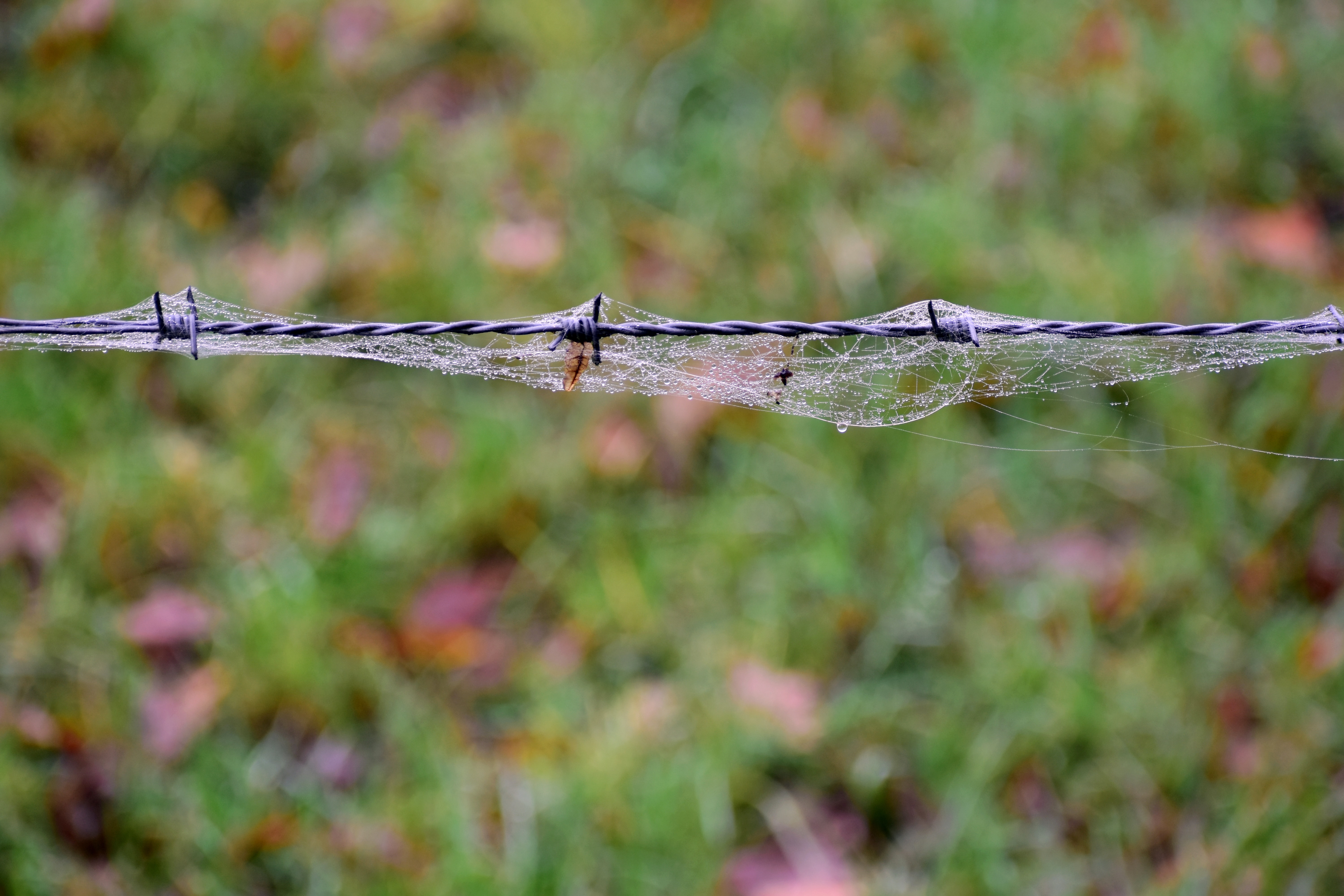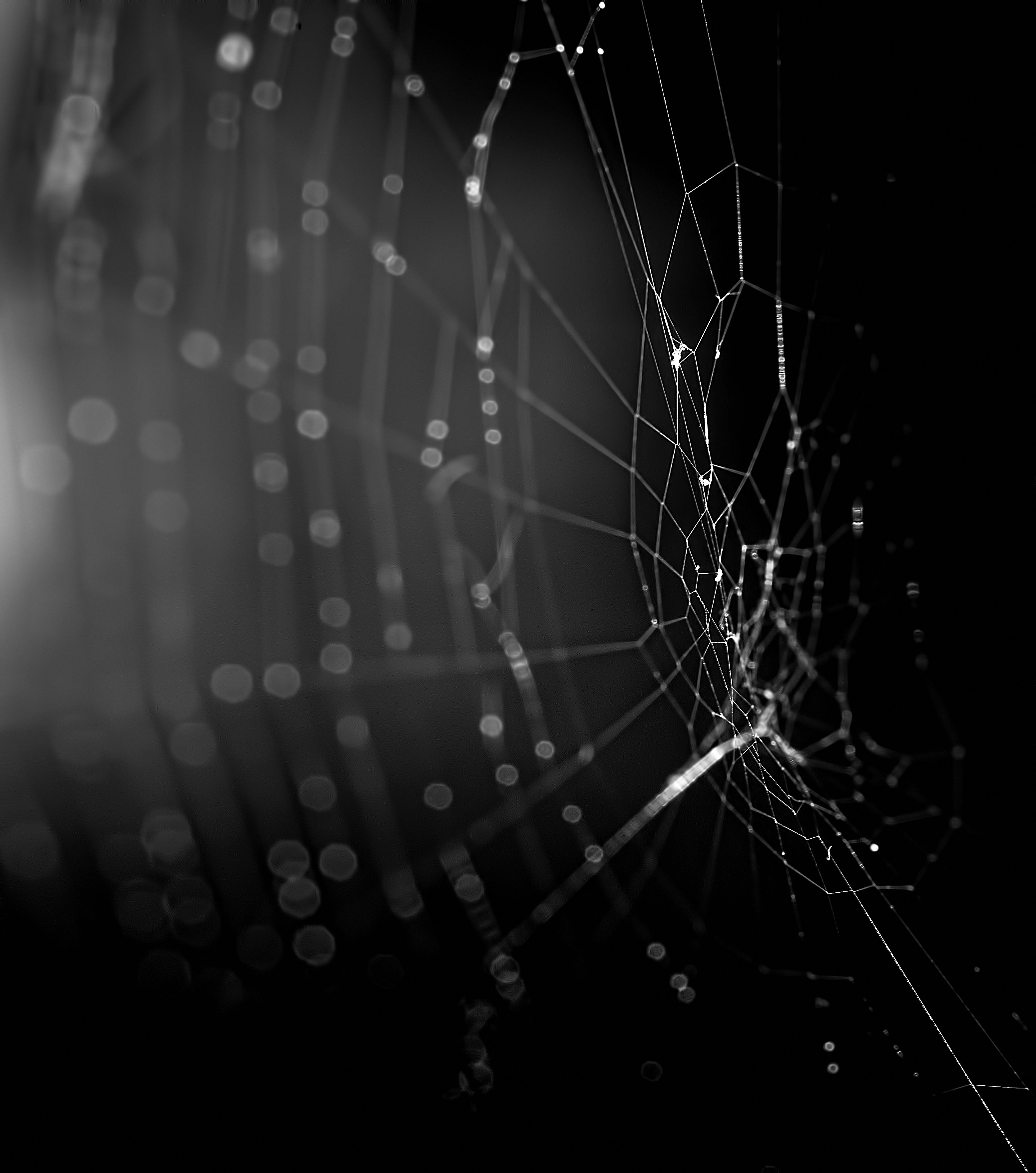Spider Webs And Their Uses
Quinn peaked out from behind the rotten logs and beheld the most beautiful sight that stole her breath away.
A spider’s nest. A Giant Zithorn Orb-weaver’s nest, by the shape of it. And, if her raveler instincts were correct—and they were always correct—the nest was unguarded.
Quinn squealed. “Score!” She skittered towards the beautiful, thick, and enormous bundle of silk. Raveler’s rules demanded that she remove only the outermost layer of silk, but only if the nest was viable. With her thick leather gloves, Quinn reached in and retracted an egg. It was far from the healthy opaque white globe she was used to seeing: dead. She reached in again, and again, and again, yet she never pulled out a healthy, living egg.
The nest was dead… which meant Raveler’s rules entitled her to 80 percent of her find. She threw her fingers into the glorious silk and set to work.
Quinn pitied the weaver tasked with untangling this tacky mess. Luckily, it wasn’t her, so Quinn enthusiastically filled her bags with her treasure. She would be swarmed by at least ten—no, a hundred buyers when she went back! Quinn would have to fill her quota with her guild first, of course, but that would leave her with at least two full bags left. A noble would pay a pretty penny for spider silk gloves or shirt for their fencing lessons. Generals would be begging her to purchase thread for their protective undershirts. And the healers—oh, the healers! They’d throw their money at her for the prime webbing.”
“A strung raveler is a wealthy raveler,” her mentor always said. And boy oh boy, was she strung now; silk spilled out of her bags, twisted through her hair, and knitted between every wrinkle on her vest and pants. With this catch, she’d be set for a year—No, two years! She could have kissed her fistfuls of silk.
Cold steel pressed up against the back of her neck. “Move, and it’ll be your last twitch.”
Quinn snarled, but kept her muscles still. “Back off. This is my find. I’m entitled to the majority of the find. Raveler’s rules.”
The blade was removed. “An unraveler?” Her would-be ambusher spat. “I thought you were the poacher.”
“You saw me arm-deep in a silk treasure trove and your first thought was that I kill spiders? Buddy, that would put me out of business. Now can I finish and leave? Or are you robbing me?”
“Typical unraveler. Head and eyes full of cobwebs, the lot of you. You question why the mother orb-weaver was nowhere to be found, nor why the entire nest is unviable? But I could use your… ‘ravler’ expertise. If there’s a poacher in the area, we need to find their next quarry. And you cob-heads have a knack for finding their territories. Therefore,” Her new “friend” motioned with their blade. “Lead on, ravler.”
Quinn grumbled. This was why she did hazard pay.
Today, we’re diving into a topic that I believe is ironically underutilized in fiction and fantasy: spiderwebs. Or, more specifically, spider silk.
I say “ironically” because giant spiders show up a ridiculous amount in fiction, almost becoming a staple in high fantasy works. There’s Shelob (from Lord of the Rings), Aragog (Harry Potter), Ungoliant (Lord of the Rings again), The monster from IT (apparently… I’ve never read the horror novel, so I’m going off of what Google says), the Portlids (Children of Time), Miss Spider (James and the Giant Peach) and many unnamed ones throughout literature like the big boy spider from Wizard of Oz. And then if you look into the fantasy worlds of table top role playing games, you’ll find civilizations that ride or fight giant arachnids on a daily basis.
(I know someone’s going to point out the Portlids weren’t super giant spiders, but they’re giant compared to a normal tiny spider!)
The fact that there’s so many spiders yet so little use of their spider silk intrigues me. And SciFi genre never touches spiders (let alone their silk), which is such a loss; scientists nowadays are searching for the best ways to harvest spider silk for its medicinal and commercial properties!
Ah, but I’m getting ahead of myself! First, let us dissect the intricacies of this spider silk at the molecular level before we discuss its uses!
First Things First… Can We Have Giant Spiders?
Before we go any further, we do need to answer one quick question about spiders before we move onto their silk.
You’ll be happy (or perhaps disappointed) to hear that giant, human-eating spiders are not scientifically impossible.
The biggest spider size I was able to find was the goliath bird-eater with a 30cm leg span (about 11 inches for my non-metric system savvy friends). No fossil record has ever shown giant spiders like what we see in fantasy. The best explanations I found were in this article here.. I personally like the speculation about how a spider’s vascular system couldn’t move around enough oxygen if the spiders got too big. That, and their exoskeletons couldn’t take the weight of their body if they got above a size.
Still, giant spiders are cool, so maybe they can still exist because of “magic” (just this once!). While we don’t necessarily need giant spiders to exist in order to harvest their silk, I like the implications of being able to collect silk from said gigantic spiders (see story intro above).
What’s So Special About Spider Silk?

Stop me if you’ve heard this before: “spider silk is stronger than steel.” Specifically, it’s 5 times stronger than steel.
That’s still a little too vague: what we mean when we say this is that the silk has a higher “tensile” strength compared to steel, meaning the maximum amount of stress silk can bear before breaking is more than steel’s strength.
Sounds fantastic, right? With enough silk, you could make a lightweight bulletproof vest. But I’m getting ahead of myself!
Let’s keep breaking down the silk. Spider silk is formed by proteins called, appropriately, “spidroins.” These proteins sit highly concentrated in the spider in a place called the “gland lumen.” When producing the silk, the spiders use 5-7 pairs of silk glands, meaning that it takes more than pulling spidroins out into the air. And when the silk is eventually pulled out, that single thread of silk is actually made up of thousands of nanostrands; think of it like a strand of rope being made up of hundreds of thinner fibers.
What about the sticky parts of a web, though? Firstly, not every spider needs their prey-capturing silk to be sticky. These types of silk are described as “wooly,” catching the prey’s leg hairs like velcro.. The spiders that create their biological glue use their aggregate glands to spread an aqueous solution of protein over their silk. Residing in that aqueous glue are glycoproteins, which is a fancy way of saying “a bunch of sugar with protein attached to it.”
For more info on the variety of spider silk, I highly recommend the first figure of this paper here, as it delves into how many unique variety of silk the dragline spider produces.
How do Spiders Use Their Silk?

We have your classic spider web, most likely spun by your friendly neighborhood orb-weaver. Not all of it is made up on the sticky silk. The “spokes” of the web are stick-less and form the skeleton of the web, while the circular strands of silk are what catch the spider’s prey. Movement on the web alerts the spider to any disturbance of the web (kind of like a jedi and the force).
If you were to examine an orb-weaver’s web, you may also see thick, white designs spun into the web. These are called stabilimentum, and I highly encourage you to check out the wiki page linked to see the variety of designs! Despite its name, stabilimentum doesn’t really stabilize the web. This paper here mentions stabilimentum reflecting ultraviolet light, which attracts both prey and predator. Adding these webbed patterns can attract more food. This article discusses why having predators notice the stabilimenta could be beneficial: it could keep birds from flying in and destroying the orb weaver’s web, or it attracts wasps for food (turning the hunter into the hunted).
From what I could gather from my limited ability to access the field’s papers, the purpose of stabilimentum is up for debate… But it is there!
What else can silk be used for though? I’m glad you asked! Some spiders weave their web into nets that they literally throw down onto their prey below (like the Ogre Faced spider). The diving bell spider uses their web to create “diving bells,” or webs that hold bubbles of air for them to breath underwater. The funnel-web spider gets its name from the web tube that it creates and ambushes from. And then there’s the triangle weaver spider that catapults the spider (using itself as a web anchor) to the prey that hits the web.
Can you imagine Shelob launching at the hobbits like a boulder from a trebuchet? I think Mr. Tolkien missed out on an opportunity there!
And not every spider uses webbing… but that’ll be for another post!
Can You Harvest Spider Silk?

If you think that we could mass harvest spider silk like we do silkworm silk… you’d be in good company. In 1709, René-Antoine Ferchault de Réaumur attempted to collect spider silk via egg sack collection, exactly how one would collect silk from silkworms. The attempt failed spectacularly.
See, spiders don’t do well in close quarters with a bunch of other spiders. They are territorial, meaning they like to kill other spiders if they get too close. That makes it hard to mass harvest the silk before any silk has even been produced. This also makes spiders hard to bred en mass.
However, scientists have been working on producing synthetic spider silk! Many experiments have involved collecting spideronin proteins produced from genetically modified bacteria, yeast, and even plants like tobacco leaves. The problem with these methods is that while the organisms chosen can absolutely produce the spider silk proteins, they lack the ability to spin said proteins into silk. You’d think this would be easily solved by using genetically modified silkworms, and indeed this has been attempted! However, we have to look at what percent of the produced worm silk is actually spider silk, and I can’t access the full article to tell you that number. The silkworm may produce spider silk, yes, but if it’s only 30% of what it makes, there’s a bit of a production issue there.
In 2022, a group of scientists successfully engineered synthetic spider silk that was comparable to naturally produced silk. The group was able to spin proteins together using a biomimetic spinning device, which I can best describe as squeezing prepared proteins through a super thin tipped syringe into an aqueous bath and then spun.
Spider Silk in Clothes?
Spider silk can absolutely be used as a lightweight material for bulletproof vests (though you’d need multiple layers, not just one thin layer.) Creating protective vests from spider silk has been an interest of the military and scientists for a while. It’s lightweight and flexible, a perfect material for maneuvering about the battlefield.
But can we use it for fashion? One company in Japan certainly thinks so, as in 2022, this company spun all of their clothing products with manufactured spider silk.
(Before you go rushing out for your new pair of spider silk socks, I must regretfully inform you that these clothes are not cheap.)
And if you want a more “organic” spider product, you would need to wait 4 years, 1 million spiders, and way too much time on your hands to traditionally weave a 11ft by 4ft scarf of silk like these folks did. Very possible, and very expensive!
Spider Silk in Medicine?
Now we get to the fun part!
What I’m most interested in is the silk’s medicinal potential. Linking spider silk to medicine is nothing new: Ancient Greeks and Romans used spider silk like gauze over their wounds. Spider silk is biodegradable, meaning your body can break it down over time. Imagine being able to use biodegradable gauze or surgical thread that’s incredibly flexible yet has more tensile strength than steel! Spider silk also doesn’t incite a strong immune response in one’s body, meaning that someone getting spider-silk stitches probably won’t getting allergies from a spider silk stitch (and yes, they are looking at using spider silk for sutures!)
Now, there is some literature out there that claims that spider silk is anti-microbial. Unfortunately, this study from 2021 was unable to replicate the anti-microbial properties other papers have claimed. But what synthetic spider silk can do is hold onto drugs (which can include antibiotics) due to the silk’s complex protein structure, making spider silk films an ideal candidate for a drug-delivery system. You could be making spider silk gauze, or using the biodegradable material for grafts like these scientists did here in rats.
For my fellow bioscience PhD students out there, this paper here used spider silk to support the growth of brain organoids. This means that the scientists were able to grow part of a brain in a dish with the help of spider silk!
This review examines the use of spider silk in biomedicine, from sutures, to drug delivery, to vaccine coatings, and to regenerative tissue medicine!
What Does This Mean for Worldbuilding or Plot?

I’ll break this down into two genres: fantasy and science fiction.
In a fantasy world, where they may not have discovered how to manufacture their own synthetic spider silk, you may want to consider having people who desire spider silk for lightweight protection. Turning silk into fabric has existed since ancient China, so the art of making spider silk textiles is absolutely feasible. A spider silk vest would not protect a character from a sword on its own, but with enough layers, it could certainly be better than nothing! A perfect “armor” for a noble.
As ancient romans were said to have used it like a gauze, we can absolutely imagine folks specializing in medicine looking to buy some of that silk. I could see it being woven to make sutures for surgeons.
Since characters wouldn’t be having spider farms due to the spider cannibalism, you’d have jobs specifically to go and harvest those spider webs. And if you’re like me and will still put inaccurate giant spiders in your work (because they’re cool, dang it!), those silk hauls will be quite profitable and dangerous. And where there’s limited resources, there’s a potential plot.
(Dungeons and Dragons enthusiasts, you are free to steal this idea for a ranger!)
And what about the sticky solution on the silk? This would be amazing natural glue and would absolutely be worth selling! Researchers have found that the natural glue can stick glass together. If a culture did not have access to other animal glue, this could be a handy alternative.
In a scifi world, they could be working on mass producing synthetic spider silk. There would still be a use for lightweight protection for law enforcement and the military, but I could also see it being a separate textile business. It could also be a socioeconomic status symbol. If you can afford silk, you’ve got money. But spider silk? You’re super loaded.
If it were my scifi world, I would absolutely start dropping mentions of its biomedical uses. I’d most likely combine it with a plot that either involved surgery or neuronal grafting. The former is the most practical use of spider silk in medicine, the latter is cool and has more plot use (scifi plots like to use neurons if they go into the realm of biology).
Takeaways
Not going to lie: after writing this post, I have a short story brewing in my little brain about spider silk!
The inspiration for this post came initially from a random google search where I wanted to know if the sugar I research, Hyluronan, is in spider silk. From there, we fell down a deeeeeeep rabbit hole.
Anyhow, that’s all that I have for this post! Happy writing everyone!
